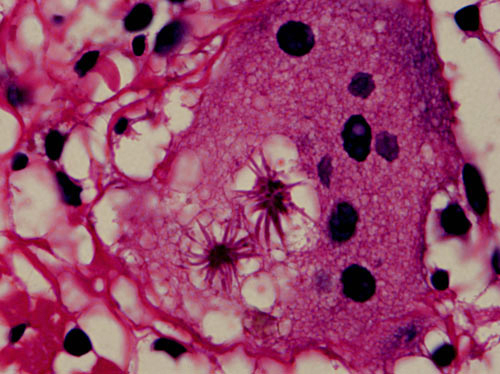Answer to Image of the Month February 2014
Submitted by Avninder Singh, V Ramesh
Asteroid body within a multinucleate giant cell
‘Asteroid’ literally means star-shaped. The term asteroid body has been applied to rather different structures.
One kind of asteroid bodies are intracellular bodies of radiating filamentous arms of myelinoid membranes that contain lipid and are seen within multinucleate giant cells (see figure below). These asteroid bodies are generally believed to be associated with sarcoidosis but may also be seen in other granulomatous conditions including foreign body granulomas.
 Asteroid bodies within a giant cell (H&E, oil immersion)
Asteroid bodies within a giant cell (H&E, oil immersion)
The other kind of asteroid bodies are seen in sporotrichosis. These are present in the extracellular matrix usually lying in a neutrophilic abscess and not within giant cells (click to see image). They consist of the spore of the fungus, Sporothrix schenckii with radiating filamentous spicules arranged around it. The ray-like asteroid structures around the sporothrix spore represent the Splendore-Hoeppli phenomenon. On staining with anti-sporothrix schenkii antibody, the spores react positively while the filaments (which are derived from the host) are negative.
Asteroid bodies are also seen in lobomycosis where they appear as single eosinophilic intracytoplasmic structures surrounded by a clear empty space that is produced by lipid extraction during tissue processing.
